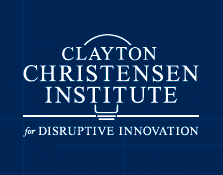What Does Competency-Based Education Have to do with Disruption?
CompetencyWorks Blog
 Originally posted May 16, 2014 at christenseninstitute.org
Originally posted May 16, 2014 at christenseninstitute.org
Last week, we published the first paper in a two-part series on competency-based education. That paper investigates what competency-based education means in practice in New Hampshire, the first state to abolish the Carnegie unit and grant high school credit on the basis of mastery rather than hours of instruction.
What does that policy—and corresponding practice—have to do with the theory of disruptive innovation? Disruptive innovation describes a force by which industries that start off expensive, centralized, and complicated (they require deep expertise) become affordable, accessible, decentralized, and offer products that are more foolproof. When we talk about disruptive innovation in education, we often think about the explosive growth of online learning over the past two decades that has offered students a new paradigm in learning. Other innovations like peer-to-peer learning or early college high school models likewise may tug at the foundation of the traditional, centralized, factory- and time-based models that have dominated our education system for over a century.
Competency-based education can significantly expand the transformational potential of such new approaches. Competency-based education offers a philosophy of how students ought to progress through material; it frees students from the lock step, age-based progressions in traditional schooling. As such, competency-based education is not in and of itself a disruptive innovation, but rather a condition that can open up more and new opportunities for disruptions to take hold and grow. Moreover, competency-based education models stand to generate demand for new types and products and services in the education market. Here are three important ways we think such approaches expand the potential of disruptive innovations in education:
Business model innovation
Disruptive innovations by definition offer new or over-served customers a product or service in a more efficient and cost-effective way than incumbent companies or institutions. This requires business model innovation—producing and delivering those products or services in a new manner, which drives down the cost of production and allows that disruption to scale upmarket over time. By removing time constraints from how we measure credit, competency-based approaches may allow students to move through material more efficiently—and in turn, more cost-effectively—than does the current system. That’s part of the value proposition we’re seeing emerge in higher education among online competency-based providers like Western Governor’s University and UniversityNow. Students at these institutions can earn their credentials as efficiently as they want, rather than on an expensive four-year schedule toward a degree.
New business models in education also may involve schools drawing on multiple service providers to supply students with multiple pathways to mastery—in other words, decentralizing the single curriculum provider model that has dominated most education systems. Because they focus on mastery—rather than inputs—competency-based models offer multiple pathways to students. The growth of the Virtual Learning Academy Charter School (VLACS) competency-recovery modules across New Hampshire is one small example of how this mentality can start to open up new space to new providers. Increasingly schools are relying on VLACS’s online modules to provide students with just-in-time or end-of-semester support on competencies where they are struggling. This is an encouraging break from the more-of-the-same remediation attempts in traditional school buildings; instead, schools are leveraging a new medium and a new provider to support students toward mastery. Taken further, students in competency-based systems may be able to access and choose from a whole range of courses or learning modules—online or offline—so long as they can demonstrate mastery on the back end.
Personalization
Competency-based education rejects the cohort model of our traditional factory-based system and instead places a fundamental emphasis on each student’s individual mastery. In other words, students in competency-based schools no longer move through material in batches or move on when a unit or course comes to an end on a teacher’s academic calendar. This week, Michael Horn summarized what we mean when we talk about personalization in education, so I won’t go into too much detail here. However, it bears mentioning that without competency-based policy—and practice—in place, our attempts to build personalized approaches are likely to remain constrained by time-based practices and business models. For example, online providers in states that still count academic credit in time must report out student learning based on these arcane metrics, rather than fully unleashing the more flexible pacing inherently possible in an online course or module.
New data and accountability
Finally, when we contemplate disruption in education, many questions remain as to how the government will hold a “next-generation” school system accountable to ensure equity, rigor, and excellence. There are a few near-term and obvious reforms—allowing high-stakes testing to occur on demand, rather than on a calendar—around which competency-based approaches will likely build momentum. But another less talked-about benefit of competency-based approaches is that students are expected to demonstrate their mastery across a variety of contexts, often using performance assessments to assess students’ ability to apply—rather than regurgitate—knowledge. As I recently heard Susan Patrick, head of iNACOL, explain, competency-based assessment has huge implications for accountability 3.0: in competency-based systems we will hopefully have more and deeper evidence of student learning by which we can in turn assess school and providers efficacy and hold them accountable for their students’ track record. These new accountability mechanisms will be vital to ensuring that disruptions are held to the most student-centered metrics and truly grow with quality.
Julia researches innovative policies and practices in K-12 education, with a focus on competency based education policies, blended learning models, and initiatives to increase students’ social capital.